By Barb Elliot
In mid July, I discovered Monarch eggs on my Swamp Milkweed.
A few days later I found three 1/8-inch caterpillars, probably a day or so old. I took them inside to raise them. Over the course of a month, I watched the amazing transformation from caterpillar to chrysalis to adult butterfly. Watching the life stages of a Monarch rejuvenates my awe at the wonders of nature.
Once inside the aquarium container, two of the caterpillars ate Swamp Milkweed and eliminated “frass”, signs that they were healthy. The third
caterpillar, however, never moved and soon died. I was reminded that caterpillars’ lives are fragile and often very short. Very few caterpillars of any species, perhaps less than one in a hundred, survive to become butterflies. The threats are legion: bacterial and fungal infections, predatory insects, spiders, birds, or other creatures looking to gulp down a neatly wrapped package of protein, plus parasites such as wasps that deposit eggs on a caterpillar so their larvae can eat the caterpillar from within.Though my yard is a certified Monarch Waystation providing optimal conditions for Monarch caterpillars and butterflies, life is tough for these creatures. By rearing some indoors, I can give them a measure of safety.
A week later, at day eight of their lives, the caterpillars stopped eating temporarily, left the milkweed for the side of the container and remained motionless for a number of hours. They were ready to shed their skin, which becomes too tight as they grow. Each shed its tiny head capsule separately and then wiggled out of its skin. This was one of five molts. Then, it was back to eating more milkweed. After all, most Monarch caterpillars increase their weight about 2,700 times from egg to chrysalis!
Two days later, I noticed only one caterpillar in the container. Alarmed, I searched and found the escapee a few feet away on my upright camera lens. I quickly returned it to the container. It moved to the top and wove a silk “button” on the screen cover. Soon it hung with its body in a “J” formation, its hind end suspended from the button. A couple of hours later, the second caterpillar was also hanging in this J shape.
In the morning I watched closely for signs that the 11-day old caterpillars were about to metamorphose into the chrysalis or pupa. Just before the transformation, each began rocking and straightening out slightly.The antenna-like tentacles drooped and looked almost segmented. Then, the skin began to split at the head end. Each caterpillar wriggled furiously as the skin split up its full length and then fell away.
Pupating caterpillar movie (Video © Barb Elliot)
At first, each pupa was yellowish green and wider at the bottom than the top. Gradually the color changed to emerald green, the shape became wider at the top and the distinctive, jewel-like gold and black markings appeared on the surface of each chrysalis. It is while in the chrysalis or pupal stage that a caterpillar undergoes metamorphosis and changes into a butterfly.
Nine days later, I noticed a few dark marks on the chrysalises, and by the tenth evening, the orange and black of forming wings were visible through the clear shell of each pupa. While I was asleep both butterflies emerged from their chrysalises. Early the next morning I saw two beautiful, fresh butterflies – one male and one female.
They were hanging from their former homes, drying and occasionally pumping their wings. I waited a few hours so they would be completely dry before I took the container outside. With a little nudging, each climbed on my finger and quickly flew off to the top of a tree where I lost sight of them.
I like to think that they stayed in my yard to nectar on flowers I grow for butterflies. Hopefully, they found mates and the female laid eggs. This next generation of Monarch butterflies, the last of this summer, will go through the same marvelous transformations and then fly 2,000 miles to their over-wintering grounds in central Mexico. That same generation will fly north into Texas in the spring of 2013 and begin the annual succession of Monarch generations that re-populate central and eastern North America each spring and summer. I hope to host Monarchs in my yard next year, raise some more caterpillars indoors, and once again experience the thrill of watching one of the true wonders of nature.
—————————————————————————————–
For information on how you can help Monarchs and/or get your yard certified, click here: Monarch Waystation
Stay tuned for a future blog with more info on Monarchs and a national effort to help them.
Below is a list of the native milkweed plants that Barb grows in her yard.
|
Locally Native Milkweed Plants** |
|||
| Botanical Name | Common Name | Bloom Color & Period | Light & Soil Conditions |
| Asclepias incarnata | Swamp Milkweed | Pink flowers; June & July | Part to full sun, moist soil |
| Asclepias tuberosa | Butterfly Milkweed | Orange flowers; June to August | Sun, dry to average soil |
| Asclepias verticillata | Whorled Milkweed | White flowers; July & August | Sun, dry to average soil |
| Asclepias purpurascens | Purple Milkweed | Dark pink/purple flowers; June & July | Part to full sun, dry/ average/moist soil |
| Asclepias syriaca* | Common Milkweed | Pink flowers; June & July | Sun, dry soil |
| *Spreads rapidly by underground rhizomes; best for large areas with other flowers and grasses | |||
| **All are deer resistant | |||

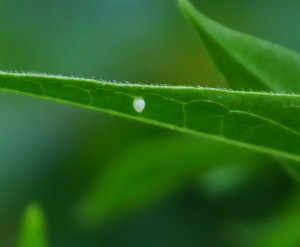
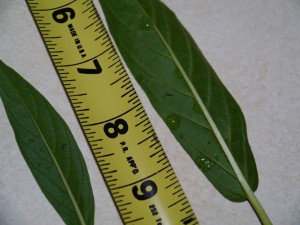
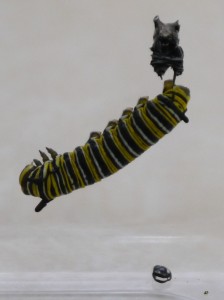

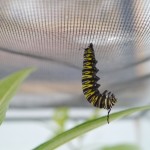
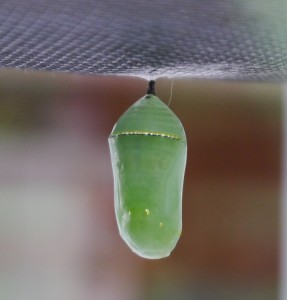
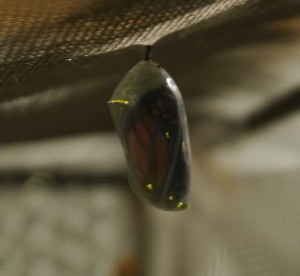
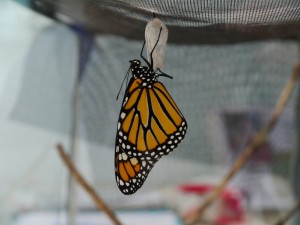
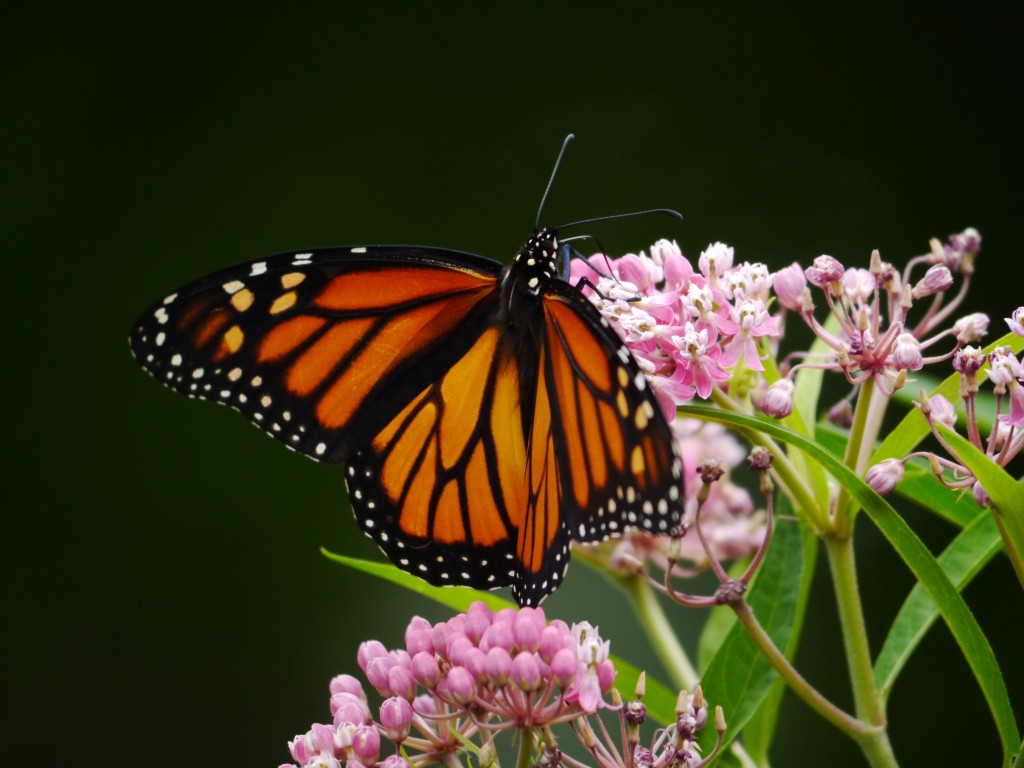
I too, have had the great experience of raising butterflies, albeit Black Swallowtails. It is truly one of lifes joys.
Barb,
What a beautiful documentary of this amazing event. Your photography is superb! Thanks for sharing with us the life history of this important creature.
Tony Fernandes
Barb, Your photographs are magnificent! I have read the metamorphosis cycle many times, but you outlined it in such a captivating, fascinating way that I was drawn in as if I had never read it before. Excellent job.
The video of the pupating caterpillar was amazing! I will share this will my 4 year old and her teachers. We are looking for caterpillars for the classroom right now out in the patches of milkweed,(also looking for Swallowtail and Tomato Hornworm caterpillars too). Hoping we will get the chance to watch it all happen in the classroom. Any advice?
Thanks, Julie. Regarding looking for caterpillars, I have found it easier to find Monarch eggs than caterpillars. The Monarchs lay a single egg at a time, and most of the ones I’ve found are on the underside of leaves. Depending on the type of milkweed, I either tilt the main stem of the plant so I can see the undersides of multiple leaves at a time, or I grab the tip of individual leaves and hold them up so I can see under them. Females are still laying eggs. I watched one flying through my garden yesterday and saw it land on several different plants and lay eggs. I have found Black Swallowtail caterpillars in the past and raised some, but don’t have as much experience with them and I’m sorry I can’t help you regarding Tomato Hornworm. Best of luck with finding some larvae to show the kids. I’m sure that getting to watch caterpillars and and the process of metamorphosis will be very exciting for them!
Barb
Barb – Your words and closeups together weave a beautiful and personal story. What a treat!
Wonderful account of an age old happening. Thanks.
A wonderful narrative, superbly illustrated, Barb.